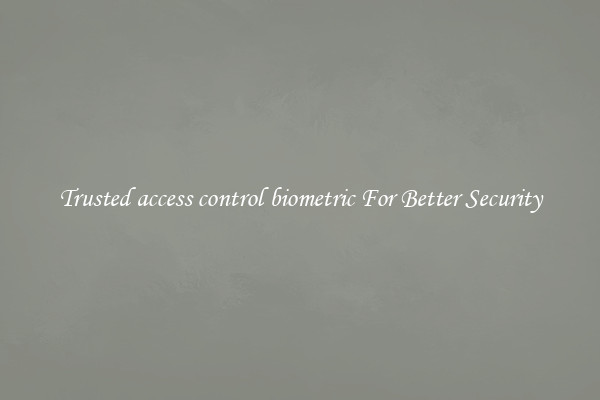Trusted access control biometric For Better Security
Trusted Access Control Biometric for Better Security

In an increasingly digital world, security measures have become more crucial than ever. Traditional methods of securing access, such as passwords and keys, are no longer enough to protect sensitive information or valuable assets. This is where trusted access control biometric technology comes into play. By utilizing unique physical or behavioral characteristics, biometric systems provide an added layer of security that is nearly impossible to replicate or forge.
Biometric access control systems use various methods such as fingerprint recognition, iris scanning, voice recognition, facial recognition, or even vein pattern recognition. Each of these methods leverages the distinct characteristics of an individual to grant or deny access. Passwords and keys can be forgotten or stolen, but biometric characteristics are inherent and cannot be easily replicated.
One of the most commonly used biometric access control methods is fingerprint recognition. Each person has a unique pattern of ridges and valleys on their fingertips, making fingerprints an excellent means of identification. By scanning a person's fingerprints, biometric systems can accurately verify their identity and allow or deny access accordingly. This method has become particularly prevalent in smartphone unlocking, replacing traditional PIN codes or patterns.
Another highly effective biometric access control method is facial recognition. Facial recognition systems analyze various features of a person's face, such as the distance between their eyes or the shape of their nose, to create a unique facial profile. This technology has seen rapid advancements in recent years, becoming faster and more accurate than ever before. Facial recognition is commonly used in airports, banks, and government facilities to ensure that only authorized individuals can gain access.
Trusted access control biometric systems not only provide enhanced security but also offer numerous advantages over traditional methods. Firstly, they eliminate the need for carrying multiple cards or remembering complex passwords. Biometric characteristics are easily accessible, making it convenient for users to access secure areas or information effortlessly.
Secondly, biometric systems significantly reduce the risk of impersonation or identity theft. Since biometric characteristics are unique to individuals and cannot be easily replicated or forged, the threat of intruders gaining unauthorized access is greatly diminished. This aspect is particularly crucial when it comes to securing sensitive information, valuable assets, or high-security areas.
Lastly, trusted access control biometric systems can provide an auditable record of access attempts. This feature allows administrators to track who accessed certain areas or information, providing valuable data in case of any suspicious activities or security breaches. Biometric systems can also be integrated with other security measures, such as video surveillance or alarm systems, to create a comprehensive security infrastructure.
In conclusion, trusted access control biometric systems have revolutionized the way we secure access to information and resources. By utilizing unique physical or behavioral characteristics, these systems provide a heightened level of security that traditional methods cannot match. With the advancement of technology and increasing concerns for security, we can expect biometric systems to become even more prevalent in the future."

View details

View details

View details

View details








